2006 SUBARU IMPREZA wheel alignment
[x] Cancel search: wheel alignmentPage 229 of 365

8-2 Driving tips
Driving tipsNew vehicle break-in driving the first 1,000 miles (1,600
km)
The performance and long life of your ve-
hicle are dependent on how you handle
and care for your vehicle while it is new.
Follow these instructions during the first
1,000 miles (1,600 km):
Do not race the engine. And do not al-
low engine speed to exceed 4,000 rpm ex-
cept in an emergency.
Do not drive at one constant engine or
vehicle speed for a long time, either fast or
slow.
Avoid starting suddenly and rapid accel-
eration, except in an emergency.
Avoid hard braking, except in an emer-
gency.
The same break-in procedures should be
applied to an overhauled engine, newly
mounted engine or when brake pads or
brake linings are replaced with new ones.
Fuel economy hints
The following suggestions will help to
save your fuel.
Select the proper gear position for the
speed and road conditions.
Avoid sudden acceleration or decelera-
tion. Always accelerate gently until you
reach the desired speed. Then try to main-
tain that speed for as long as possible.
Do not pump the accelerator and avoid
racing the engine.
Avoid unnecessary engine idling.
Keep the engine properly tuned.
Keep the tires inflated to the correct
pressure shown on the tire placard, which
is located under the door latch on the driv-
er s side. Low pressure will increase tire
wear and fuel consumption.
Use the air conditioner only when nec-
essary.
Keep the front and rear wheels in prop-
er alignment.
Avoid carrying unnecessary luggage or
cargo.
Engine exhaust gas (Carbon
monoxide)
Never inhale engine exhaust gas.
Engine exhaust gas contains car-
bon monoxide, a colorless and
odorless gas which is dangerous,
or even lethal, if inhaled.
Always properly maintain the en-
gine exhaust system to prevent
engine exhaust gas from entering
the vehicle.
Never run the engine in a closed
space, such as a garage, except
for the brief time needed to drive
the vehicle in or out of it.
Avoid remaining in a parked vehi-
cle for a lengthy time while the en-
gine is running. If that is unavoid-
able, then use the ventilation fan
to force fresh air into the vehicle.
Always keep the front ventilator
inlet grille free from snow, leaves
or other obstructions to ensure
that the ventilation system always
works properly.
Page 311 of 365
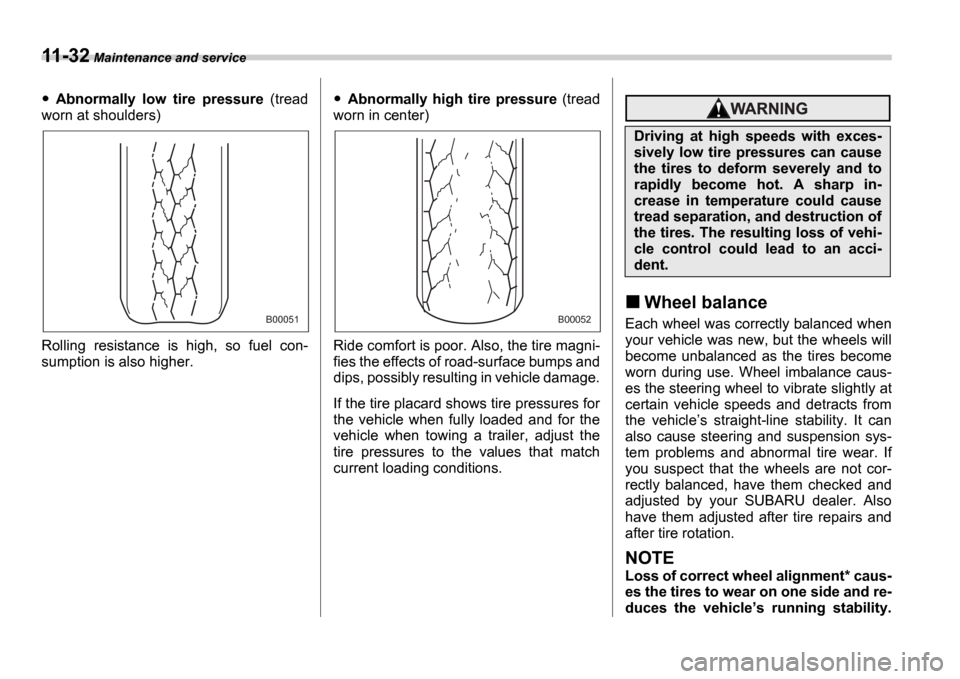
11-32 Maintenance and service
Abnormally low tire pressure (tread
worn at shoulders)
Rolling resistance is high, so fuel con-
sumption is also higher.Abnormally high tire pressure (tread
worn in center)
Ride comfort is poor. Also, the tire magni-
fies the effects of road-surface bumps and
dips, possibly resulting in vehicle damage.
If the tire placard shows tire pressures for
the vehicle when fully loaded and for the
vehicle when towing a trailer, adjust the
tire pressures to the values that match
current loading conditions.
Wheel balance
Each wheel was correctly balanced when
your vehicle was new, but the wheels will
become unbalanced as the tires become
worn during use. Wheel imbalance caus-
es the steering wheel to vibrate slightly at
certain vehicle speeds and detracts from
the vehicle s straight-line stability. It can
also cause steering and suspension sys-
tem problems and abnormal tire wear. If
you suspect that the wheels are not cor-
rectly balanced, have them checked and
adjusted by your SUBARU dealer. Also
have them adjusted after tire repairs and
after tire rotation.
NOTE
Loss of correct wheel alignment* caus-
es the tires to wear on one side and re-
duces the vehicle s running stability.
B00051B00052
Driving at high speeds with exces-
sively low tire pressures can cause
the tires to deform severely and to
rapidly become hot. A sharp in-
crease in temperature could cause
tread separation, and destruction of
the tires. The resulting loss of vehi-
cle control could lead to an acci-
dent.
Page 312 of 365
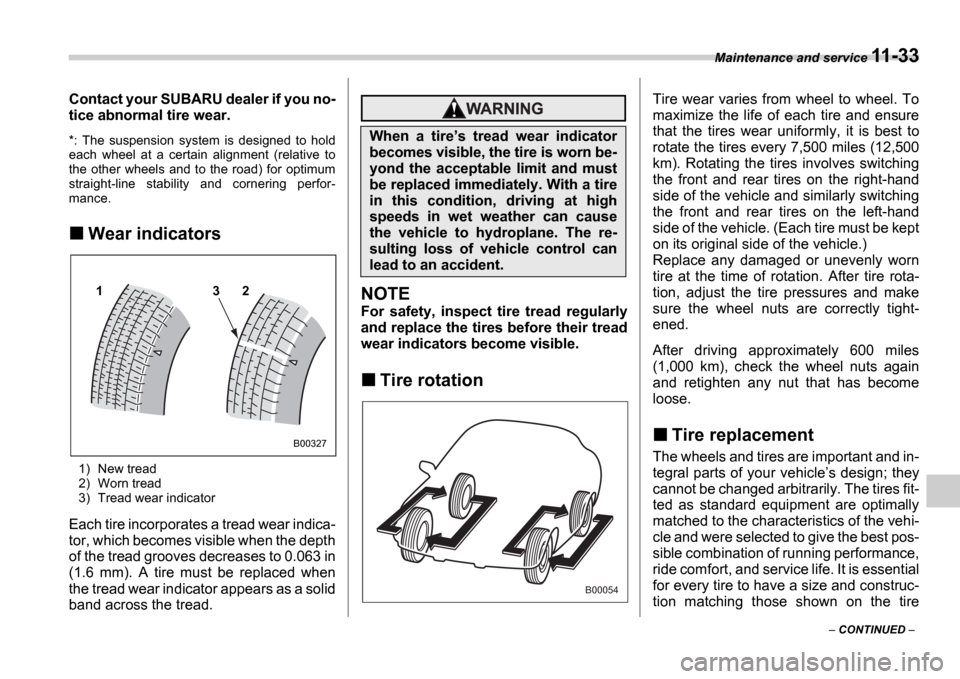
Maintenance and service 11-33
CONTINUED
Contact your SUBARU dealer if you no-
tice abnormal tire wear.
*: The suspension system is designed to hold
each wheel at a certain alignment (relative to
the other wheels and to the road) for optimum
straight-line stability and cornering perfor-
mance.
Wear indicators
1) New tread
2) Worn tread
3) Tread wear indicator
Each tire incorporates a tread wear indica-
tor, which becomes visible when the depth
of the tread grooves decreases to 0.063 in
(1.6 mm). A tire must be replaced when
the tread wear indicator appears as a solid
band across the tread.
NOTE
For safety, inspect tire tread regularly
and replace the tires before their tread
wear indicators become visible.
Tire rotation
Tire wear varies from wheel to wheel. To
maximize the life of each tire and ensure
that the tires wear uniformly, it is best to
rotate the tires every 7,500 miles (12,500
km). Rotating the tires involves switching
the front and rear tires on the right-hand
side of the vehicle and similarly switching
the front and rear tires on the left-hand
side of the vehicle. (Each tire must be kept
on its original side of the vehicle.)
Replace any damaged or unevenly worn
tire at the time of rotation. After tire rota-
tion, adjust the tire pressures and make
sure the wheel nuts are correctly tight-
ened.
After driving approximately 600 miles
(1,000 km), check the wheel nuts again
and retighten any nut that has become
loose.
Tire replacement
The wheels and tires are important and in-
tegral parts of your vehicle s design; they
cannot be changed arbitrarily. The tires fit-
ted as standard equipment are optimally
matched to the characteristics of the vehi-
cle and were selected to give the best pos-
sible combination of running performance,
ride comfort, and service life. It is essential
for every tire to have a size and construc-
tion matching those shown on the tire
1 2 3
B00327
When a tires tread wear indicator
becomes visible, the tire is worn be-
yond the acceptable limit and must
be replaced immediately. With a tire
in this condition, driving at high
speeds in wet weather can cause
the vehicle to hydroplane. The re-
sulting loss of vehicle control can
lead to an accident.
B00054
Page 332 of 365
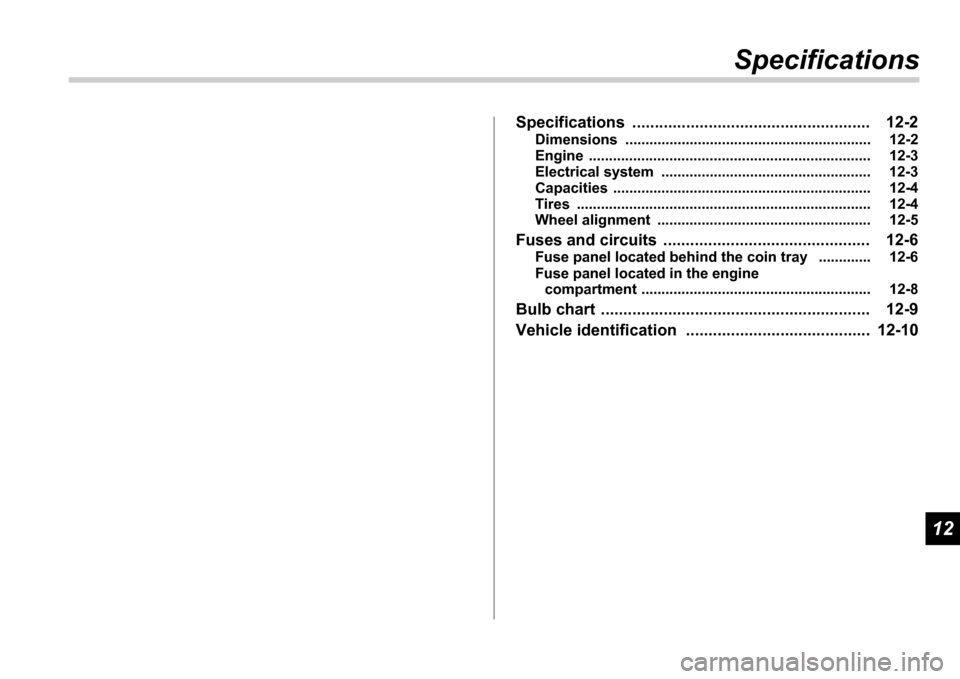
12
Specifications
Specifications ..................................................... 12-2
Dimensions ........................................ ..................... 12-2
Engine ............................................ .......................... 12-3
Electrical system ................................. ................... 12-3
Capacities ........................................ ........................ 12-4
Tires ............................................. ............................ 12-4
Wheel alignment ................................... .................. 12-5
Fuses and circuits ................................ .............. 12-6
Fuse panel located behind the coin tray .......... ... 12-6
Fuse panel located in the engine compartment ....................................... .................. 12-8
Bulb chart ........................................ .................... 12-9
Vehicle identification ............................ ............. 12-10
Page 336 of 365
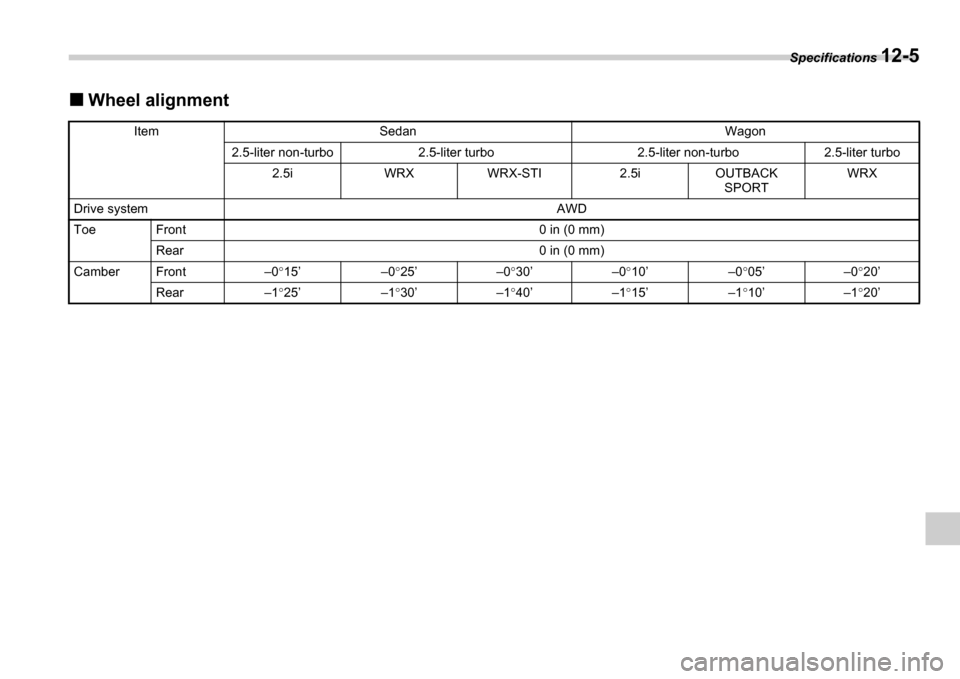
Specifications 12-5
Wheel alignment
ItemSedanWagon
2.5-liter non-turbo2.5-liter turbo2.5-liter non-turbo2.5-liter turbo
2.5iWRXWRX-STI2.5iOUTBACK
SPORTWRX
Drive systemAWD
ToeFront0 in (0 mm)
Rear0 in (0 mm)
CamberFront015 025 030 010 0 05 0 20
Rear125 130 140 115 1 10 1 20
Page 363 of 365
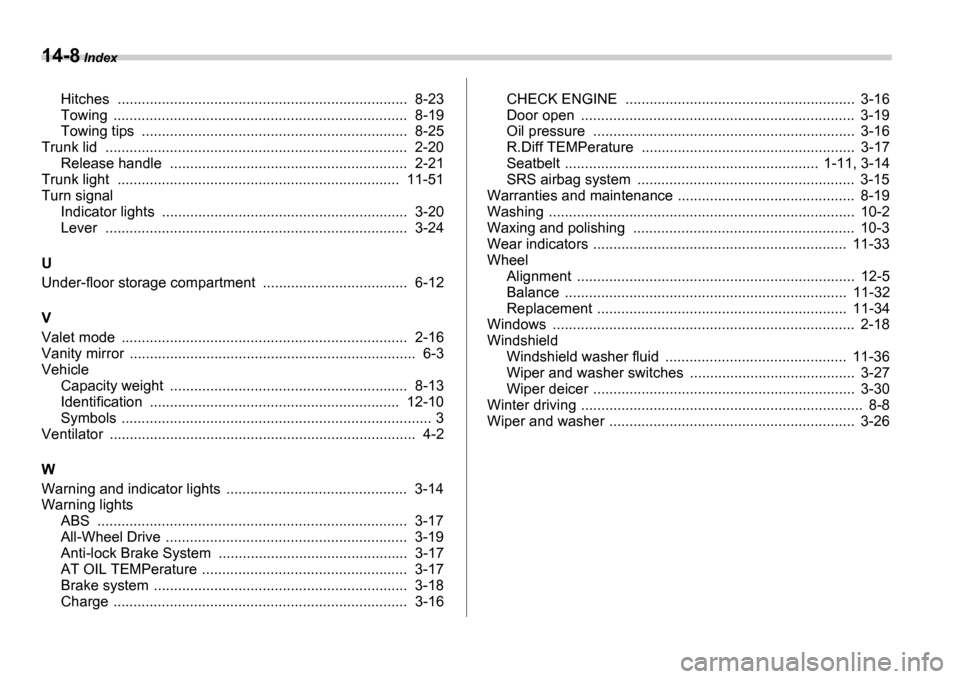
14-8 Index
Hitches ............................................. ........................... 8-23
Towing ............................................ ............................. 8-19
Towing tips ........................................ .......................... 8-25
Trunk lid .......................................... ................................. 2-20
Release handle ..................................... ...................... 2-21
Trunk light ........................................ .............................. 11-51
Turn signal
Indicator lights .................................... ......................... 3-20
Lever .............................................. ............................. 3-24
U
Under-floor storage compartment ..................... ............... 6-12
V
Valet mode ........................................ ............................... 2-16
Vanity mirror ...................................... ................................. 6-3
Vehicle Capacity weight ..................................... ...................... 8-13
Identification ..................................... ......................... 12-10
Symbols ............................................ ................................. 3
Ventilator ........................................ .................................... 4-2
W
Warning and indicator lights ........................ ..................... 3-14
Warning lights
ABS ............................................... .............................. 3-17
All-Wheel Drive .................................... ........................ 3-19
Anti-lock Brake System ................................ ............... 3-17
AT OIL TEMPerature ................................ ................... 3-17
Brake system ......................................... ...................... 3-18
Charge ............................................ ............................. 3-16CHECK ENGINE ......................................
................... 3-16
Door open ......................................... ........................... 3-19
Oil pressure ....................................... .......................... 3-16
R.Diff TEMPerature ................................ ..................... 3-17
Seatbelt .......................................... ..................... 1-11, 3-14
SRS airbag system ................................... ................... 3-15
Warranties and maintenance .......................... .................. 8-19
Washing ............................................ ................................ 10-2
Waxing and polishing .............................. ......................... 10-3
Wear indicators ..................................... .......................... 11-33
Wheel Alignment ......................................... ............................ 12-5
Balance ............................................ .......................... 11-32
Replacement ....................................... ....................... 11-34
Windows ............................................ ............................... 2-18
Windshield Windshield washer fluid ............................ ................. 11-36
Wiper and washer switches ............................. ............ 3-27
Wiper deicer ....................................... .......................... 3-30
Winter driving ..................................... ................................. 8-8
Wiper and washer ................................... .......................... 3-26